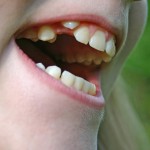
The prevalence of palatally displaced permanent canines is reported to be between 1-3%. Unerupted permanent canines may cause the resorption of the roots in adjacent teeth or more rarely cyst formation. Management of palatally displaced canines may require surgery and fixed appliance therapy.
The main aim of this Cochrane review was to assess the efficacy, safety and cost-effectiveness of any interceptive procedure to promote the eruption of palatally displaced canines (PDC).
Methods
Searches were conducted in the Cochrane Oral Health’s Trials Register, Cochrane Central Register of Controlled Trials (CENTRAL), Medline, Embase, ClinicalTrials.gov and the WHO International Clinical Trials Registry Platform. Randomised controlled clinical trials (RCTs) in children with one or both permanent maxillary canines palatally displaced with at least 80% of patients aged 9 to 14 years undergoing an intervention to enable successful eruption of the unerupted PDC compared with untreated controls or alternative interventions were considered. The primary outcome was incidence of eruption of the PDC into the mouth. Two reviewers independently and in duplicate., selected studies extracted data and assessed risk of bias. The primary outcome was summarised with risk ratios (RR) and 95% confidence intervals (CI)
Results
- 4 RCTs involving a total of 199 patients were included.
- 82 patients had a unilateral PDC, 117 a bilateral PDC.
- 2 studies were at high risk of bias and 2 at unclear risk.
- 1 study (45 patients) found
- extraction of the primary canine may increase the proportion of PDCs that successfully erupt into the mouth at 12 months compared with no extraction, RR = 2.87 (95%CI: 0.90 to 9.23) [ very low-certainty evidence].
- no evidence that extraction of the primary canine reduced the number of patients with a PDC referred for surgery at 12 months, RR = 0.61 (95%CI: 0.29 to 1.28) [ very low-certainty evidence].
- 3 RCTs (119 patients) found no difference in the proportion of successfully erupted PDCs at 18 months with a double primary tooth extraction compared with extraction of a single primary canine, RR = 0.68 (95%CI :0.35 to 1.31) [ very low-certainty evidence].
- Two of these 3 RCTs found no difference in the proportions referred for surgical exposure between the single and the double primary extraction groups data at 48 months, RR = 0.31(95%CI: 0.06 to 1.45) [ very low-certainty evidence].
- There are some descriptive data suggesting that the more severe the displacement of the PDC towards the midline, the lower the proportion of successfully erupted PDCs with or without intervention.
Conclusions
The authors concluded: –
The evidence that extraction of the primary canine in a young person aged between 9 and 14 years diagnosed with a PDC may increase the proportion of erupted PDCs, without surgical intervention, is very uncertain. There is no evidence that double extraction of primary teeth increases the proportion of erupted PDC compared with a single primary tooth extraction at 18 months or the proportion referred for surgery by 48 months. Because we have only low to very low certainty in these findings, future research is necessary to help us know for sure the best way to deal with upper permanent teeth that are not erupting as expected.
Comments
This Cochrane review updates and expands an earlier review by Parkin et al (Dental Elf – 14th Dec 2012). The extraction of primary canine teeth when clinicians suspect the displacement of the permanent canine has become almost standard clinical practice. This is thought to be based on a paper by Ericson and Kurol published in 1998 (Ericson & Kurol, 1988) who reported on a a series of 35 children with no control group. While this current review found a higher proportion of successfully erupted PDCs following extraction the confidence intervals are wide and include the possibility that there is no difference. In addition, none of the included studies were at low risk of bias. The review’s discussion includes an interested section of criteria to define PDCs and the age at which PDCs can be reliable identified. Both these issues need to be addressed and agreed to inform new well conducted and reported trials which are needed to clarify the management of upper permanent canines that do not appear to be erupting as anticipated.
Links
Primary Paper
Benson PE, Atwal A, Bazargani F, Parkin N, Thind B. Interventions for promoting the eruption of palatally displaced permanent canine teeth, without the need for surgical exposure, in children aged 9 to 14 years. Cochrane Database Syst Rev. 2021 Dec 30;12(12):CD012851. doi: 10.1002/14651858.CD012851.pub2. PMID: 34967448; PMCID: PMC8717471.
Other references
Ericson S, Kurol J. Early treatment of palatally erupting maxillary canines by extraction of the primary canines. Eur J Orthod. 1988 Nov;10(4):283-95. doi: 10.1093/ejo/10.4.283. PMID: 3208843.
Cochrane Oral Health Blog – Interventions to encourage eruption of eye teeth buried under the gum or growing upwards, without the need for surgery, in children aged 9 to 14 years
Dental Elf – 14th Dec 2012
Dental Elf – 21st Aug 2017
Interceptive primary canine extraction for palatally displaced permanent canines
Dental Elf 17th Aug 2020
Palatally Displaced Permanent Canines: Interceptive management
